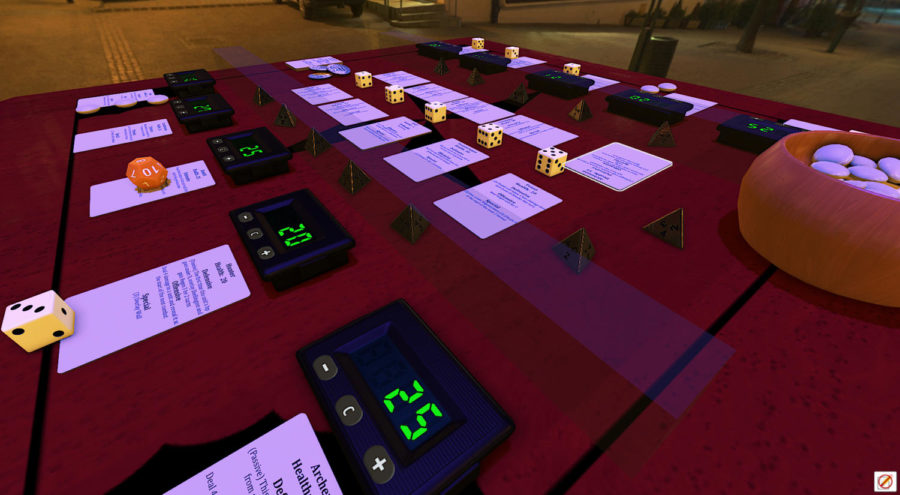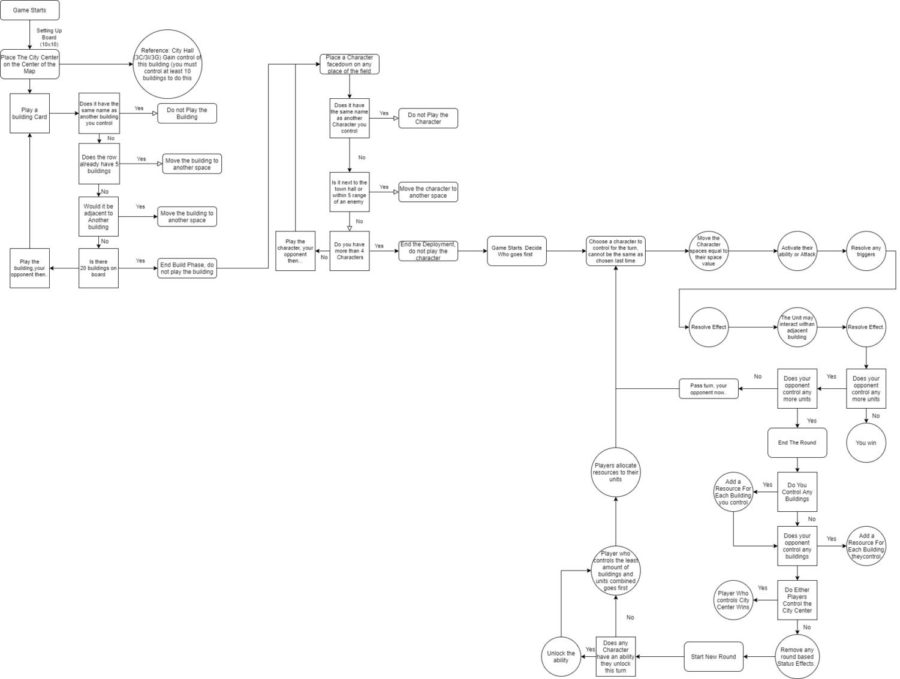Mechanics Loosely Strung: Lessons and Truths About Making a Game
There are a few things with game design that come with experience and experience only, so here are a few lessons that I have learned in my experiences designing games.
Here is a prototype in Table Top Simulator, an online simulators that allows your game to get play-tested by people outside your immediate friend group.
The process of creating a game is arduous and filled with failure. It may take a game designer years of trial and error before they ever complete their first game. But for the past year, I have been designing, testing and scrapping games, and recently, I have been fortunate enough to participate in an in-depth talk with a game designer and entrepreneur. And through this process, I have derived several truths about making a game that you may find helpful on your own journey.
Your game is not unique
Every game takes from another game. If a game has a genre or can be categorized, it’s going to be similar to another game in the same genre. League of Legends took from DotA Allstars, DotA Allstars took from Aeons of Strife, and Aeons of Strife took from Future Cop(Multiplayer gameplay). No game is ever truly unique; they all take from a predecessor.
But that does not mean you cannot create something unique, you can always deviate to make a game yours. As the old proverb goes, “don’t reinvent the wheel.” Instead, improve upon that wheel and use its structure to create your car. In my interview with Keith A. Rice, an aspiring game designer and current entrepreneur, he made it clear that his game takes elements from others. In regards to the history of the game, “I began considering how to create a tabletop implementation of Castles 2: Siege and Conquest, and later Heroes of Might and Magic 3. In the following two decades, I tinkered with various ideas and prototypes, but nothing felt right, and I would frequently put away the project for years at a time,” said Rice.
Another , in the mobile game Clash Royale, cards are designed to be stronger against certain enemies and weaker against others. This creates a pseudo rock-paper-scissors dynamic where card A counters card B, which counters card C, and then card C counters card A. But Clash Royale isn’t rock-paper-scissors. It improves on it by adding skill expression with unit positioning and card synergy.
Here’s a visual demonstration of the interactions. The Valkyrie beats the army of skeletons very easily, but loses to the prince, which loses to the army of skeletons. Creating the rock-paper-scissors loop of Valkyrie -> Skeleton Army -> Prince -> Valkyrie
But it is important to innovate, as you are trying to deliver a unique gaming experience. But, it is also important to keep some familiarity that players usually expect. Reinventing core mechanics does not make your game better, it makes it confusing. Akiva Josephs ’22 stated, “the longer it takes for me to understand the game, the less likely I am to start working to set it up.”
Less is more
Of the six different designs I have made, five of them were bloated beyond belief. In fact, the first time I showed my design to a professional in the games industry, the first words I got were, “I hate everything about this, I don’t know what’s going on, and I’m confused.” Why? Because my game was too complicated, and it didn’t have a clear goal.
The designer did not know how to play my game because it was muddled. He felt like many mechanics in my game had no reason to exist, and it was true. I thought these mechanics were interesting and cool but did not consider whether they were necessary. This is not an uncommon experience either. Rice said, “the biggest design challenge is fighting the urge to make the game more complex than it needed to be. My game may yet fail, but it would have certainly failed if I had not reined in the complexity of the original design, I believe. It’s easy for designers to think, ‘This mechanic is so innovative and cool, I MUST include it,’ even though it isn’t essential to delivering the core experience.”
Although this is a harsh lesson for many first-time game designers, it is imperative that you have a clear goal to work towards. If your design process is “This seems cool! Let me add it,” then stop and ask yourself, “Is this integral to my game?” Because if it isn’t, then you are just bloating your game.
You are not designing for yourself
Mark Rosewater, current head designer for Magic: The Gathering (MTG), has said in the past that it is important for players to have a sense of ownership over their game pieces. Let them use their cards to make subgames and their own experiences. For example, one of MTG’s most popular modes of play to this day is a fan-made format called Commander, where players use a legendary card and 99 other unique cards in order to build a deck. This resulted in similar formats popping up, and even official support by the company behind MTG.
In my first three designs, I always created games I wanted to play. I took inspiration from games I loved, but in doing that, I forced play-testers into a specific play style that I preferred. I was making a game that didn’t feel like a game, but rather an interactive movie, where no matter the choice the players made, the results were the same.
The main lesson here is that your game is only a way of play, not the only way to play. It is easy to get caught up in the idea of creating your dream game, but you need to remember that you are creating an experience for others. Instead of forcing players down one path, give them choices. What matters is that your players feel like they are at the helm of their experience, not you.
Fun is foremost
Although many games nowadays are designed for the sake of competitiveness, ultimately, most of a game’s player base is not playing to become the next top player. When I was talking to game designers, I was told one thing repeatedly: “Players can choose what they want to play, but they can’t choose what they want to play against.” In a game with player to player interaction, you should make sure that your game pieces are both fun to play, and to play against.
Take stun mechanics for example. Though most stun mechanics are fair, as they provide some form of disruption at the cost of either more resources or less damage, they are also the least fun mechanics in the game, as players are physically unable to play the game. As a result, most stuns and disruptions are made to be skill based effects that can be avoided by the player. One example of skill based disruption are Catchers found in the roguelike game, Dead Cells. These enemies use a hook and sickle combo to stun the player and pull them in. However, you can dodge the hook through a multitude of ways, as displayed below.
It is imperative that players feel as if they’re on the same level as their opponent. Players need to feel like they have a chance to win. They cannot feel like the game’s outcome was out of their control, and they especially cannot feel like they wasted their time. Your game can be competition centered and balanced, but in the end, “The reason people play games is for enjoyment, therefore entertainment value should be prioritized. Balance goes hand in hand with this, as its sole purpose is to ensure that people have as much fun as possible,” said Justin Zheng ’23.
You’re going to fail. A lot.
Game design might seem scary at first, but that is okay. It is important to understand that although your game may not be a commercial success, you will learn from it. Rice has put countless hours and a wealth of resources into creating a game he likes. He has said repeatedly, “It may fail yet, and that’s OK. I have a clear idea of what I am willing to risk, and I always view my projects as a win-win experience, even if they do fail, by virtue of how much I learn and grow.”
One thing I took away from making games, testing them, and showing it to people is that my games were not that good at first. And now, they are better. I have not succeeded in any of my designs, and I do not think I will ever make a smash success. But every design that I make and share is a step towards improving my skills. To me, making a game is a process of trial and error, and it is a process of learning people’s hearts.
Game design is difficult, but it remains one of my favorite hobbies because although successes are short lived, they’re plentiful. One success could mean ten more problems, but that only means that by the time you’re done, you would have succeeded ten times more. And although you may be confused and frustrated now, tomorrow, you’ll have a new idea. So keep trying, and keep failing, because failure only propels you forward.
The process of creating a game is arduous and filled with failure. It may take a game designer years of trial and error before they ever complete their first game…but that only means that by the time you’re done, you would have succeeded ten times more.
Tiankuo Zhang is an Editor-In-Chief for 'The Science Survey.' He sees journalism as something that has withstood the test of time and finds the transcriptions...


